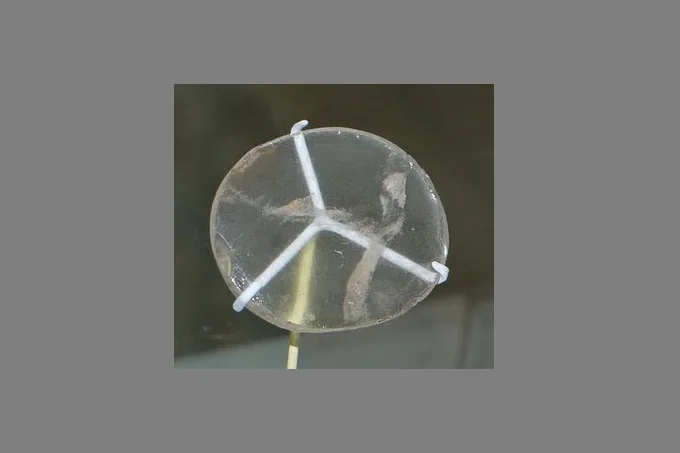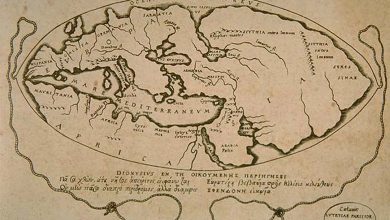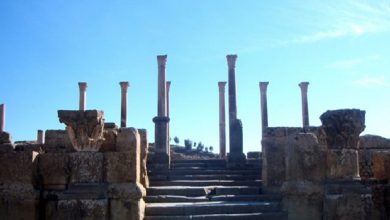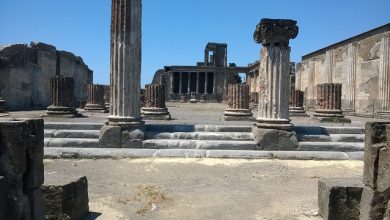Ancient lenses: Did advanced optics exist in ancient times?

Archaeologists have not noticed them for more than a century. We are talking about optical lenses – thin instruments made of various materials that prove the existence of advanced optics already in ancient times.
Were people able, several thousand years ago, to make precise optical instruments with which to correct astigmatism, observe distant stars, and carry out work at the microscopic level?
Robert Temple, an expert on ancient lenses (famous for his book about the cosmic knowledge of the Dogon tribe “The Secret of Sirius”) is sure not only of this but also that the evidence of such an unexpected assumption has been at hand for at least a hundred years.
Over the past three decades, Robert, demonstrating superhuman perseverance and having developed his own special method of work, has been running around the world, finding out, during trips, that there are a huge number of objects in museums that were mistakenly recorded as jewelry, beads, etc. However, their true purpose was quite different – to improve the visibility of distant or microscopic objects, to focus the solar light for the production of fire, and even for orientation…
The first surprise for the researcher turned out, that he wrote in his monograph “Crystal Sun”, that in classical texts, as well as in the oral cultural and religious traditions of many peoples, there are numerous indications of the existence of optical devices in them. These instructions could well have attracted the attention of historians and archaeologists for a long time, causing them to want to find the described devices.
However, as the author bitterly admits, a negative tradition has developed in the scientific community, which denies the possibility of the existence of any developed technology in ancient times. For example, some objects, whose shape and material inevitably suggest that they served as lenses, were classified as mirrors, earrings, or, at best, as incendiary glasses, that is, lenses, but used exclusively for focusing sunlight and lighting fires.
Paradoxically, the small crystal spheres manufactured by the Romans and used by them as lenses, when filled with water, were painted as vessels for cosmetics and perfumes. In both cases, according to Robert, there was special myopia of modern science, which he intends to prescribe good glasses.
Miniature models from the time of Pliny
Ancient references to lenses have been relatively easy to trace since the time of Pliny the Elder (I century), although, as we will see later, similar indications can be found in the “Pyramid Texts”, which are more than 4000 years old, and even earlier – in same Ancient Egypt.
In his Natural History, Pliny describes the laborious work with miniature objects that Calicrates and Myrmekides, two ancient Roman artists and artisans, were engaged in, in about these words: “Calicrates managed to make models of ants and other tiny creatures whose body parts remained invisible to other people. A certain Myrmekid earned fame in the same field by making a small cart with four horses of the same material, so tiny that a fly could cover it with its wing, and a ship of the same size.”
If Pliny’s stories make a great impression, then no less exciting is the mention of a miniature copy of the Iliad, made on such a small piece of parchment that the whole book could fit in a nutshell, as Cicero, the author of the previous century, was the first to say. The closer to us, the more often classical authors include in their works data about these now lost objects, the manufacture of which obviously required the use of optical devices.
According to Temple, “the first modern author of optical devices—apart from magnifying glasses—was the Italian Francesco Vettori, who created a microscope in 1739. Vettori was a connoisseur of antique gems and said that he had seen some of them, the size of half a grain of lentils, which, nevertheless, were skillfully processed, which he considered impossible unless we admit that the ancients had powerful magnifying devices.”
When working with ancient jewelry, the existence of the now lost optical technology becomes apparent. Many experts have intuitively pointed it out for several centuries, however, for some reason this fascinating area of the history of science has remained completely unexplored.
Karl Sittle, a German art critic, claimed back in 1895 that there was a portrait on a stone with a diameter of barely 6 millimeters of the Pompeii Dam, the wife of the Roman emperor Trajan, who lived in the I century. Sittle pointed to it as an example of the use of optical means of magnification by ancient carvers.
The Stockholm Historical Museum and the Shanghai Museum store artifacts made of various metals, such as gold or bronze, on which miniature work is clearly visible, as well as on numerous clay tablets from Babylon and Assyria, microscopic cuneiform signs are visible.
Such tiny inscriptions were so numerous, especially in Greece and Rome, that Robert Temple had to abandon the idea of finding and classifying them all. The same is true for the lenses themselves, which he did not expect to find more than a few pieces, but he cites as many as 450!
As for the glass spheres used as incendiary glasses and for cauterizing wounds, they have also been preserved in many different museums, despite their fragility, but have always been classified as vessels for storing special liquids.
From death rays to ancient Egyptian optics
The fact that the optical technologies of antiquity are not at all an illusion, a “deception of vision”, can be understood if you carefully re-read the classics, thoroughly search through museum catalogues and reinterpret some myths. One of the most obvious examples from the latter area is the legend of the divine fire, which was passed on to people by various heroes, as happened with Prometheus – it is enough just to accept that people possessed tools capable of “getting fire out of nowhere.”
The Greek author Aristophanes generally speaks directly in his comedy “Clouds” about the lenses with which the fire was kindled back in the V century BC. Apparently, the druids were able to do the same. They used transparent minerals to reveal the “invisible substance of fire.”
But the most striking application of such technology is found in Archimedes with his giant mirrors. There is no need to recall here all the scientific contributions of this genius, who was born in Syracuse and lived from 287 to 212 BC. However, it must be said that during the siege of Syracuse in 212 by the Roman fleet of Claudius Marcellus, Archimedes managed to set fire to the Roman trieres, focusing and directing the sun’s rays on them with the help of huge, presumably metal mirrors.
The veracity of this episode was traditionally questioned until November 6, 1973, when Ioannis Sakas repeated it in the port of Piraeus and set fire to a small ship with the help of 70 mirrors.
Evidence of this subsequently forgotten knowledge is found everywhere, exposing the fact that the lives of ancient people were much richer and more inventive than our conservative mind is sometimes able to admit. Here, the old saying is justified better than anywhere else, that the world is seen depending on the color of the glass through which we look at it.
Another important find that Temple introduces us to is the fruit of hard work in the field of bibliography and philology. It was to them that Dr. Michael Weitzman from the University of London devoted his time, he showed that the term “totaphot”, which is used in the biblical Books of Exodus and Deuteronomy to refer to phylacteries fixed on the forehead during religious services, was originally called an object that was placed between the eyes.
And as a result, we have another description of glasses, and, according to Weitzman, the best expert on ancient Jewish history in England, glasses that originate from Egypt.
There is nothing strange that in the land of the pharaohs, they were familiar with them even before the actual pharaohs appeared there. After all, this is the only way to explain the presence of microscopic drawings on the handle of an ivory knife, which was found in the 1990s by Dr Gunther Dreyer, director of the German Institute in Cairo, at the Umm el-Qabb cemetery in Abydos.
Surprisingly, the knife dates back to the pre-dynastic era, the so-called “Nagada-II period”, that is, about the 34th century BC. In other words, it was made 5,300 years ago!
This real archaeological mystery presents to us – which can only be assessed with a magnifying glass — a series of human figures and animals whose heads do not exceed one millimeter.
Temple, apparently, is absolutely convinced that optical technologies appeared in Egypt and were used not only in the manufacture of miniature images and in everyday life, but also in the construction and orientation of buildings in the Ancient Kingdom, as well as for the production of various lighting effects in temples by means of polished disks and in the calculation of time.
The false eyes of the statues of the IV, V, and even III dynasties were “convex crystal lenses, perfectly processed and polished”, they increased the size of the pupils and gave the statues a revived look. In this case, the lenses were made of quartz, and evidence of its abundance in ancient Egypt in large quantities can be found in museums and books on Egyptology. Thus, it turns out that the “Eye of Horus” was another type of optical device.
The Layard lens and others
The prototype of the extensive series of evidence collected by Temple was the Layard lens. It is this stone that is at the very beginning of his thirty-year epic and, due to the enormous importance that it represents for a profound revision of history, is kept in the Department of Western Asian Antiquities of the British Museum.
The lens was found during the excavations carried out by Austin Henry Layard in 1849 in Iraq in one of the halls of the palace in Kalhu, also known as the city of Nimrud. It is only part of the complex of finds, which includes a huge number of items belonging to the Assyrian king Sargon, who lived in the VII century BC.
We are talking about an object made of rock crystal, ellipsoid shape, 4.2 centimeters long and 3.43 centimeters wide, with an average thickness of 5 millimeters.
Initially, this lens had a frame, possibly made of gold or other precious metal, fitted with great care, but it was stolen and sold by workers from the excavation. However, the most surprising thing is that we are talking about a real flat-convex lens, which was cut in the form of a toroid, completely wrong in a layman’s opinion, and with numerous slots on a flat surface.
At the same time, it is absolutely obvious that it was used to correct astigmatism. Therefore, the diopter calibration on this lens is different in its different parts, from 4 to 7 units, and the levels of increasing diopters range from 1.25 to 2.
The manufacture of such a device required the highest accuracy of work. At first, its surface was completely flat on both sides and had perfect transparency – a quality that, naturally, is now largely lost due to numerous cracks, dirt clogged into micropores, and other influences that inevitably leave their traces on an artifact of 2.5 thousand years old.
It is very significant that the lens has the size of an eyeball and even matches the parameters with some modern standard lenses.
When he stumbled upon the history of this lens and finished analyzing it, his work began, leading to the identification and study of more than 450 lenses worldwide. The discoverer of Troy Schliemann found 48 lenses in the ruins of the mythical city, of which one was particularly distinguished by the perfection of workmanship and traces of familiarity with the engraver’s tools.
As many as 30 lenses were found in Ephesus, and, characteristically, they were all concave and reduced the image by 75 percent, and in Knossos, in Crete, as it turned out, lenses were made in such quantities that they even managed to find a real workshop of the Minoan era for their production.
The Cairo Museum has a copy of a round lens of the III century BC, five millimeters in diameter, preserved in excellent condition and magnifying 1.5 times.
In the Scandinavian countries, the number of ancient lenses discovered is approaching a hundred, and 16 of them were found in the ruins of Carthage – all flat-convex, all made of glass, with the exception of two made of rock crystal.
It is obvious that after the publication of the book “Crystal Sun” and its translation into other languages, new lenses, incendiary glasses, “smaragda” and other pieces of evidence of the optical art of antiquity will be found, which have been gathering dust in museums for many decades or even centuries without any sense.
However, it is not necessary to see in these pieces of evidence traces of the presence of aliens on our Earth or the existence of some forgotten civilizations with extremely advanced technologies. All of them only point to the normal evolutionary development of science and technology, based on the study of nature through the accumulation of empirical knowledge, through trial and error.
In other words, we are witnessing the ingenuity of human genius, and only man is responsible for both the occurrence of such miracles and their oblivion.
Millennial Glasses
We already know that the Biblical term “totafot” was probably of Egyptian origin and meant an object similar to our glasses. However, the best example of the use of glasses in antiquity is given to us by the infamous Nero, about whom the same Pliny provides exhaustive information.
Nero was short-sighted and, in order to observe gladiatorial fights, he used “smaragds”, pieces of greenish crystal that not only corrected vision defects, but also visually approximated objects. That is, we are talking about a monocle, which, quite possibly, was held on a metal stand, and its lens was probably made of a green gem like an emerald or of convex-faceted glass.
In the last century, experts have debated a lot on the topic of Nero’s myopia and came to the conclusion that the invention of vision correction tools two thousand years ago is quite possible, in contrast to the traditionally accepted opinion about the appearance of glasses in the XIII century.
Temple concludes: “Ancient glasses, of which, in my opinion, there were a lot, were a kind of pince-nez fixed on the nose, or a kind of theatrical binoculars, which were brought to the eyes from time to time.”
As for the question whether or not they had any frames, then, apparently, it can be answered positively: the frames were and they were attached, just as they are now, behind the ears.
“It is possible that these frames were made of soft and short-lived materials, like leather or even twisted fabric, and because of this, they sat very comfortably on the nose. However, I believe that most of the ancient convex lenses made of glass or crystal used to correct vision were never worn permanently on the face. I think they were held in their hand, for example, when reading, held up to the page like a magnifying glass, in cases when some word on the page was illegible,” concludes Temple




